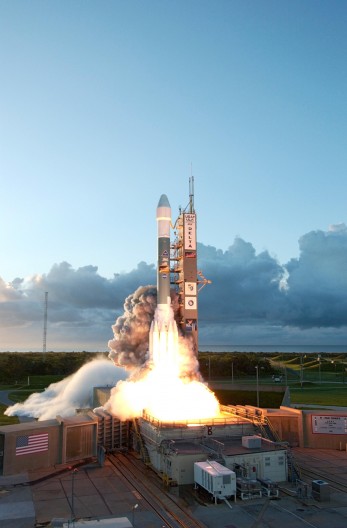
Artist's impression of Dawn orbiting the dwarf planet Ceres (Image: NASA/JPL-Caltech/UCLA)
NASA's Dawn spacecraft has recovered from an unexpected phenomenon that resulted in the robotic explorer going into safe mode on September 11, mirroring a similar event that affected the spacecraft three years ago as it approached the protoplanet Vesta. Dawn was launched in September 2007 atop a Delta II-Heavy rocket with a mission to explore Vesta and the dwarf planet Ceres.
Currently, the unmanned explorer is well under way to its final scientific destination, Ceres, that it is due to reach in April 2015 – a full month later than originally scheduled, thanks to Thursday's setback.
The probe carries three instruments: a visible light camera, a gamma ray and neutron spectrometer, and a visible and infrared mapping spectrometer. By examining Vesta and Ceres with these instruments, Dawn will compare the evolutionary paths taken by each of the celestial bodies, informing current theories on the processes that formed our early solar system.
The team theorized that a collision with a high-energy radiation particle had corrupted software running in the main computer, as was believed to be the case with the probe's earlier malfunction that occurred three years previously. The phenomenon caused the spacecraft to enter a safe mode, shutting off the probe's ion thrusters in the process. The situation was further complicated by the discovery that Dawn had suffered a second malfunction, that had affected the spacecraft's capacity to orientate her main antenna towards Earth – a process vital for the communication and relaying of orders.
NASA operators were quick to address the problem. "We followed the same strategy that we implemented three years ago to recover from a similar radiation strike – to swap to one of the other ion engines and a different electronic controller so we could resume thrusting quickly," states Marc Rayman, Dawn Mission Director and Chief Engineer. The secondary issue relating to the probe's antenna was remedied via a full computer reset that succeeded in restoring the component’s operational capacity.
Rayman went on to explain that the ion engine affected by the incident was not lost, stating that "we have a plan in place to revive this disabled component later this year."
Source: NASA
copyright © Gizmag 2003 - 2014
http://www.gizmag.com/nasa-dawn-spacecraft-safe-mode-ion-engine/33853
